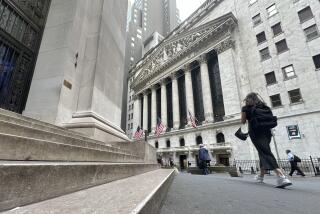Search for Stock Trends Grows Futile
No investment strategy is simpler than trend extrapolation.
That is the human tendency to assume that a stock price, an economic indicator or anything else traveling in a particular direction for a significant period is likely to continue along the same path for the foreseeable future.
Often, it isn’t a bad bet. In fact, it can be a highly profitable investment strategy, because laws of physics have applications even in securities markets: Bodies in motion tend to stay in motion, etc.
Trend extrapolation is just a fancier term for momentum investing--going with the flow, buying what’s already going up or selling what’s going down. But as so many investors have learned since the stock market peaked in spring 2000, trends eventually terminate, at which point they often have violent reversals.
In the aftermath, many people will say, “I should have seen it coming.” But an upward-slanting line on a chart begs to be extended along the same axis. Halting that line seems the unnatural thing. Extrapolation makes more sense.
A major source of aggravation for many investors today is the seeming lack of trends to play--up or down. The stock market, as measured by its major indexes, has stayed within a relatively narrow range since mid-June.
The Nasdaq composite index, which fell 5.3% last week to end Friday at 1,956.47, has mostly bounced between 1,950 and 2,100 since June 15. The Standard & Poor’s 500 index, off 2% last week to 1,190.16 as of Friday, has mostly bounced between 1,170 and 1,230 since June 15.
Rallies within individual industry stock sectors have been occurring, but they typically last for only a few days, or a few weeks at most, before fizzling.
Case in point: gold-mining stocks. An S&P; index of four major gold stocks surged in April and May, then began to sell off. The index has staged three rallies since late May--the latest was last week--but they all quickly petered out. The result is that the index, at 115.88 on Friday, is at the same level as in early May.
Some market sectors have been a bit more convincing in their moves, but not by much. The 15-stock Dow utility index has slumped about 10% since early May. The energy crisis, as an investment theme, has lost a big chunk of its former fan base on Wall Street.
For the market overall, economic uncertainty most often gets the blame for the dearth of trends, and it’s as good an excuse as any. When will the economy, and corporate profits, turn around? The answer has become more elusive as summer has worn on.
Last week, the Federal Reserve’s latest “beige book” survey of economic conditions by region suggested that weakness is spreading, though apparently not at an alarming rate. A weaker economy could mean another round of interest rate cuts by the Fed. But the stock market can’t seem to get excited about that prospect anymore.
On Friday, long-term Treasury bond yields slid to four-month lows after the government said wholesale prices fell 0.9% in July, the biggest drop in eight years, thanks to a reversal in energy costs. The absence of inflation pressures gives the Fed more leeway to further reduce its benchmark short-term rate, now at a seven-year low of 3.75%.
Yet the technology-dominated Nasdaq composite index’s close Friday was its lowest since April 17, as it slipped below the previous summer closing low of 1,959.32 reached on July 24.
What’s more, the calendar now is stacked against the stock market. The July-through-October period historically has been the weakest of the year for share prices, according to data compiled by Hirsch Organization of Old Tappan, N.J.
Investors with longer-than-average memories may recall that stocks staged a surprising rally in August 2000, raising hopes that the decline that began that spring had run its course.
Instead, major indexes peaked Sept. 1 and dived almost relentlessly from Sept. 2 through mid-October and again in November. The S&P; 500 sank 5.3% in September, 0.5% in October and 8% in November. Nasdaq’s losses in those three months were 12.7%, 8.3% and 22.9%, respectively.
Talk about trend extrapolation: In retrospect, of course, the smart move last fall was to view September’s loss as a sign of much more to come. By October, weary investors were taking solace in that month’s historical record as a bear slayer; some of Wall Street’s worst bear markets bottomed in October, including those of 1960, 1966, 1974, 1987 and 1990, according to Hirsch.
But October couldn’t stop the 2000 bear, which then turned more vicious this year. For now, market optimists are clinging to the belief that the two-year lows reached by key indexes in late March or early April won’t be revisited, and will have officially marked the end of the 2000-2001 bear.
The S&P; 500’s closing low was 1,103.25 on April 4, so it would take a 7.3% drop from Friday’s close to reach new depths. Nasdaq’s low was 1,638.80, also on April 4, so it would have to slide 16.2% from Friday’s level to make a new low.
If those depths are revisited in coming months, investors’ tendency to extrapolate could become the market’s worst enemy, at the time of year when it’s hardest for share prices to rally anyway.
Plenty of investors have cash they’d like to put to work in stocks, eventually. But a weak market heading into a traditionally weak season would give those with cash one more reason to keep it sidelined in the safety of a money market fund, a short-term bank account or a secret chest in the garage.
Tom Petruno can be reached at [email protected]. For recent columns on the Web, go to http://vinapk.com/petruno.
More to Read
Inside the business of entertainment
The Wide Shot brings you news, analysis and insights on everything from streaming wars to production — and what it all means for the future.
You may occasionally receive promotional content from the Los Angeles Times.










